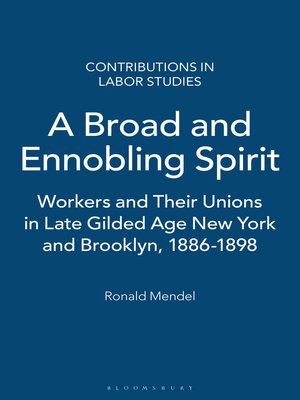A Broad and Ennobling Spirit
ebook ∣ Workers and Their Unions in Late Gilded Age New York and Brooklyn, 1886-1898 · Contributions in Labor Studies
By Ronald Mendel

Sign up to save your library
With an OverDrive account, you can save your favorite libraries for at-a-glance information about availability. Find out more about OverDrive accounts.
Find this title in Libby, the library reading app by OverDrive.



Search for a digital library with this title
Title found at these libraries:
| Library Name | Distance |
|---|---|
| Loading... |
With the introduction of new production methods and technological innovation, tradesmen and workers encountered new challenges. This study examines the development of trade unions as a manifestation of working class experience in late Gilded Age America. It underscores both the distinctive and the common features of trade unionism across four occupations: building tradesmen, cigar makers, garment workers, and printers. While reactions differed, the unions representing these workers displayed a convergence in their strategic orientation, programmatic emphasis and organizational modus operandi. As such, they were not disparate organizations, concerned only with sectional interests, but participants in an organizational-network in which cooperation and solidarity became benchmarks for the labor movement.
Printers coped with the mechanization of typesetting by promoting greater cooperation among the different craft unions within the industry, with the aim of establishing effective job control. Building tradesmen exerted a pragmatic militancy, which combined strikes with overtures to the employers' business sense, to uphold the standards of craft labor. Cigar makers, especially handicraftsmen who found their position threatened by machinery and the growth of factory production, debated the merits of a craft-based union against the possible advantages of an industrial-oriented organization. Garment workers, caught in the snare of a sweating system of labor in which wages and work loads were inversely related, organized unions to mount strikes during the busy season in the hope of securing higher wages, only to see them whither in the midst of slack periods.
Printers coped with the mechanization of typesetting by promoting greater cooperation among the different craft unions within the industry, with the aim of establishing effective job control. Building tradesmen exerted a pragmatic militancy, which combined strikes with overtures to the employers' business sense, to uphold the standards of craft labor. Cigar makers, especially handicraftsmen who found their position threatened by machinery and the growth of factory production, debated the merits of a craft-based union against the possible advantages of an industrial-oriented organization. Garment workers, caught in the snare of a sweating system of labor in which wages and work loads were inversely related, organized unions to mount strikes during the busy season in the hope of securing higher wages, only to see them whither in the midst of slack periods.







